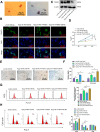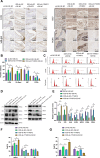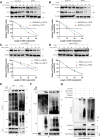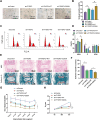New perspectives on YTHDF2 O-GlcNAc modification in the pathogenesis of intervertebral disc degeneration
- PMID: 39425013
- PMCID: PMC11488288
- DOI: 10.1186/s10020-024-00876-x
New perspectives on YTHDF2 O-GlcNAc modification in the pathogenesis of intervertebral disc degeneration
Abstract
This study investigates the potential molecular mechanisms by which O-GlcNAc modification of YTHDF2 regulates the cell cycle and participates in intervertebral disc degeneration (IDD). We employed transcriptome sequencing to identify genes involved in IDD and utilized bioinformatics analysis to predict key disease-related genes. In vitro mechanistic validation was performed using mouse nucleus pulposus (NP) cells. Changes in reactive oxygen species (ROS) and cell cycle were assessed through flow cytometry and CCK-8 assays. An IDD mouse model was also established for in vivo mechanistic validation, with changes in IDD severity measured using X-rays and immunohistochemical staining. Bioinformatics analysis revealed differential expression of YTHDF2 in NP cells of normal and IDD mice, suggesting its potential as a diagnostic gene for IDD. In vitro cell experiments demonstrated that YTHDF2 expression and O-GlcNAcylation were reduced in NP cells under H2O2 induction, leading to inhibition of the cell cycle through decreased stability of CCNE1 mRNA. Further, in vivo animal experiments confirmed a decrease in YTHDF2 expression and O-GlcNAcylation in IDD mice, while overexpression or increased O-GlcNAcylation of YTHDF2 promoted CCNE1 protein expression, thereby alleviating IDD pathology. YTHDF2 inhibits its degradation through O-GlcNAc modification, promoting the stability of CCNE1 mRNA and the cell cycle to prevent IDD formation.
Keywords: CCNE1; Cell cycle; Intervertebral disc degeneration; O-GlcNAc modification; Oxidative stress; YTHDF2.
© 2024. The Author(s).
Conflict of interest statement
The author declares no conflict of interest.
Figures











Similar articles
-
YTHDF2-dependent m6A modification of FOXO3 mRNA mediates TIMP1 expression and contributes to intervertebral disc degeneration following ROS stimulation.Cell Mol Life Sci. 2024 Dec 3;81(1):477. doi: 10.1007/s00018-024-05503-w. Cell Mol Life Sci. 2024. PMID: 39625652 Free PMC article.
-
Abnormal stress promotes intervertebral disc degeneration through WTAP/YTHDF2-dependent TIMP3 m6A modification.J Cell Physiol. 2024 May;239(5):e31219. doi: 10.1002/jcp.31219. Epub 2024 Feb 12. J Cell Physiol. 2024. PMID: 38345407
-
The matrikine N-acetylated proline-glycine-proline induces premature senescence of nucleus pulposus cells via CXCR1-dependent ROS accumulation and DNA damage and reinforces the destructive effect of these cells on homeostasis of intervertebral discs.Biochim Biophys Acta Mol Basis Dis. 2017 Jan;1863(1):220-230. doi: 10.1016/j.bbadis.2016.10.011. Epub 2016 Oct 19. Biochim Biophys Acta Mol Basis Dis. 2017. PMID: 27769935
-
NF-κB signalling pathways in nucleus pulposus cell function and intervertebral disc degeneration.Cell Prolif. 2021 Jul;54(7):e13057. doi: 10.1111/cpr.13057. Epub 2021 May 24. Cell Prolif. 2021. PMID: 34028920 Free PMC article. Review.
-
Role of the mechanosensitive piezo1 channel in intervertebral disc degeneration.Clin Physiol Funct Imaging. 2023 Mar;43(2):59-70. doi: 10.1111/cpf.12798. Epub 2022 Dec 8. Clin Physiol Funct Imaging. 2023. PMID: 36400723 Review.
Cited by
-
N6-methyladenosine and intervertebral disc degeneration: Advances in detection and pathological insights.J Orthop Translat. 2025 Jun 5;53:38-51. doi: 10.1016/j.jot.2025.05.004. eCollection 2025 Jul. J Orthop Translat. 2025. PMID: 40529901 Free PMC article. Review.
-
Integrating Bulk RNA and Single-Cell Sequencing Data Reveals Genes Related to Energy Metabolism and Efferocytosis in Lumbar Disc Herniation.Biomedicines. 2025 Jun 24;13(7):1536. doi: 10.3390/biomedicines13071536. Biomedicines. 2025. PMID: 40722613 Free PMC article.
-
The m6A reader YTHDF2 protects vascular smooth muscle cells against the osteogenic differentiation through targeting Runx2.Ren Fail. 2025 Dec;47(1):2488876. doi: 10.1080/0886022X.2025.2488876. Epub 2025 Apr 14. Ren Fail. 2025. PMID: 40230077 Free PMC article.
-
Intervention effect of regulating GABA-A receptor activity on the formation of experimental abdominal aortic aneurysm in rats.Sci Rep. 2024 Dec 28;14(1):31388. doi: 10.1038/s41598-024-82913-7. Sci Rep. 2024. PMID: 39732918 Free PMC article.
References
-
- Adan A, Alizada G, Kiraz Y, Baran Y, Nalbant A. Flow cytometry: basic principles and applications. Crit Rev Biotechnol. 2017;37(2):163–76. 10.3109/07388551.2015.1128876. - PubMed
-
- Cao S, Liu H, Fan J, et al. An oxidative stress-related gene pair (CCNB1/PKD1), competitive endogenous RNAs, and Immune-infiltration patterns potentially regulate intervertebral disc Degeneration Development. Front Immunol. 2021;12:765382. 10.3389/fimmu.2021.765382. Published 2021 Nov 9. - PMC - PubMed
MeSH terms
Substances
Grants and funding
LinkOut - more resources
Full Text Sources
Miscellaneous

